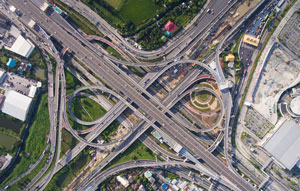How Highway Stimulus Spending Turned into a Dead End

Increased infrastructure spending, particularly on the nation’s highways, was a key component of the American Recovery and Reinvestment Act of 2009, the economic stimulus package aimed to combating the Great Recession.
The Recovery Act gave state governments $27.5 billion in grants through the Federal Highway Administration (FHWA). Yet, this didn’t lead to a big investment in the U.S. highway system, according to a recent Economic Synopses essay.
Some States Cut Spending
Economist Bill Dupor and Research Intern Jack Garton found that highway system saw little improvement despite the federal money. The number of federal aid highway workers remained relatively unchanged immediately after the legislation was passed; so did the total value of highway construction.
“In fact, 40 percent of Americans lived in states that spent less on highway infrastructure in 2010 than in 2008 or almost exactly the same in those years,” they wrote.
Rather than boost highway spending, these 16 states increased spending in other areas. (See table.)
| Changes in State Dollars Per Capita Spending Between 2008 and 2010 (in Millions) |
|||
|---|---|---|---|
| State |
Highway
infrastructure
|
Government
administration
|
Government
administration
plus education
|
| Georgia | -$109 | -$9 | $82 |
| Texas | -$98 | $20 | $288 |
| Maryland | -$73 | $4 | $129 |
| Kentucky | -$45 | $0 | $147 |
| Virginia | -$44 | $9 | $5 |
| Florida | -$35 | -$16 | -$24 |
| Indiana | -$28 | -$18 | $559 |
| Louisiana | -$21 | $18 | $13 |
| Alabama | -$12 | $3 | -$20 |
| Mississippi | -$10 | $20 | $58 |
| Ohio | -$10 | -$38 | $131 |
| Hawaii | -$9 | -$58 | -$169 |
| Illinois | -$9 | $9 | $83 |
| Colorado | -$7 | -$4 | $236 |
| Arkansas | -$6 | -$13 | $129 |
| Kansas | $1 | $24 | $86 |
| NOTE: Spending in each category reflects state government spending from all sources (i.e., own state and federal). | |||
| SOURCE: Dupor (2017) and his calculations based on FHWA National Highway Statistics and U.S. Census Bureau Annual Survey of State and Local Governments data. | |||
| Federal Reserve Bank of St. Louis | |||
Crowding Out
Why did this happen? They suggested that the economic concept of “crowding out” occurred: that is, the federal money crowded out state funds for highway spending.
Because of the 2007-2009 recession, state governments faced sharp declines in tax revenue. The federal money allowed them to cut their own highway spending and repurpose that money for other needs, according to the authors.
Dupor and Garton wrote that lawmakers were aware this could happen and attempted to address this concern. However, the Recovery Act allowed states to spend federal money with no need to match their own funds.
The authors cited Dupor’s 2017 paper that estimated that every $1 of additional FHWA money through the Recovery Act raised highway spending by only 19 cents.1
“This implies that for each dollar received, state governments cut their own contribution to highway infrastructure by 81 cents,” they wrote.
Conclusion
Because of the language in the legislation and the incentives for states to repurpose the money, overall highway spending levels were likely very similar to what they would have been without the Recovery Act, according to the authors.
“The inability of the Recovery Act to substantially improve U.S. highways serves as a reminder that crowding out is a potential problem for any government stimulus and that seemingly small details in legislation can have significant economic consequences,” they concluded.
Notes and References
1 Dupor, Bill. “So, Why Didn’t the 2009 Recovery Act Improve the Nation’s Highways and Bridges?” Federal Reserve Bank of St. Louis Review, Second Quarter 2017, Vol. 99, Nov. 2, pp. 169-82.
Additional Resources
- Economic Synopses: Why the 2009 Recovery Act Didn’t Improve the Nation’s Highways
- On the Economy: Which Was Bigger: The 2009 Recovery Act or FDR's New Deal?
- On the Economy: How Did the Recovery Act Impact School Jobs?
Citation
ldquoHow Highway Stimulus Spending Turned into a Dead End,rdquo St. Louis Fed On the Economy, Dec. 11, 2017.
This blog offers commentary, analysis and data from our economists and experts. Views expressed are not necessarily those of the St. Louis Fed or Federal Reserve System.
Email Us
All other blog-related questions

